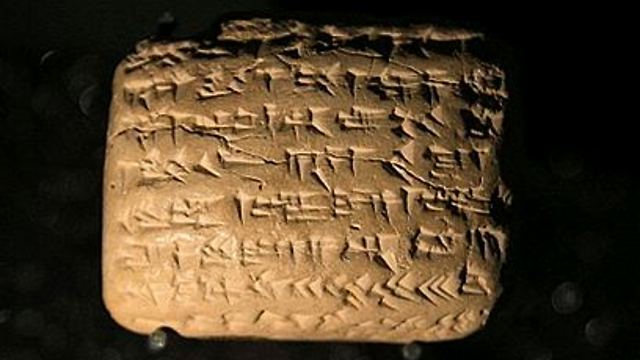
Ancient tablets on display in Jerusalem reveal Jewish life during Babylon exile
Tablets from 500-600 BCE shown for first time; exhibition reveals life of Judeans in ancient Babylon; tablets contain details of business, contracts, families.
A new exhibition in Jerusalem of ancient clay tablets discovered in modern-day Iraq is shedding light for the first time on the daily life of Jews exiled to Babylon some 2,500 years ago.
The exhibition is based on more than 100 cuneiform tablets, each no bigger than an adult's palm, that detail transactions and contracts between Judeans driven from, or convinced to move from, Jerusalem by King Nebuchadnezzar around 600 BC.
Archaeologists got their first chance to see the tablets -- acquired by a wealthy London-based Israeli collector -- barely two years ago. They were blown away.
"It was like hitting the jackpot," said Filip Vukosavovic, an expert in ancient Babylonia, Sumeria and Assyria who curated the exhibition at the Bible Lands Museum.
"We started reading the tablets and within minutes we were absolutely stunned. It fills in a critical gap in understanding of what was going on in the life of Judeans in Babylonia more than 2,500 years ago."
Nebuchadnezzar, a powerful ruler famed for the Hanging Gardens of Babylon, came to Jerusalem several times as he sought to spread the reach of his kingdom.
Each time he came -- and one visit coincided with the destruction of Jerusalem's first temple in 586 BC -- he either forced or encouraged the exile of thousands of Judeans.
One exile in 587 BC saw around 1,500 people make the perilous journey via modern-day Lebanon and Syria to the fertile crescent of southern Iraq, where the Judeans traded, ran businesses and helped the administration of the kingdom.
"They were free to go about their lives, they weren't slaves," Vukosavovic said. "Nebuchadnezzar wasn't a brutal ruler in that respect. He knew he needed the Judeans to help revive the struggling Babylonian economy."
The tablets, each inscribed in minute Akkadian script, detail trade in fruits and other commodities, taxes paid, debts owed and credits accumulated.
The exhibition details one Judean family over four generations, starting with the father, Samak-Yama, his son, grandson and his grandson's five children, all with Biblical Hebrew names, many of them still in use today.
"We even know the details of the inheritance made to the five great-grandchildren," said Vukosavovic. "On the one hand it's boring details, but on the other you learn so much about who these exiled people were and how they lived."
Vukosavovic describes the tablets as completing a 2,500-year puzzle. While many Judeans returned to Jerusalem when the Babylonians allowed it after 539 BC, many others stayed and built up a vibrant Jewish community that lasted two millennia.
"The descendants of those Jews only returned to Israel in the 1950s," he said, a time when many in the diaspora moved from Iraq, Persia, Yemen and North Africa to the newly created state.











